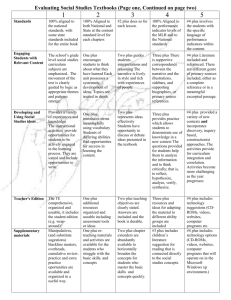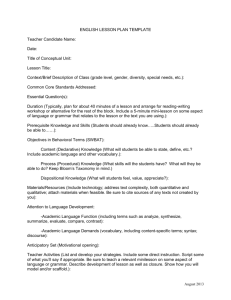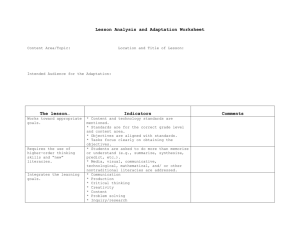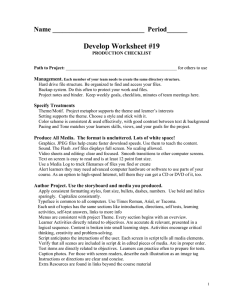THE STUDENT TEACHING UNIT PLAN Directions Background:
advertisement
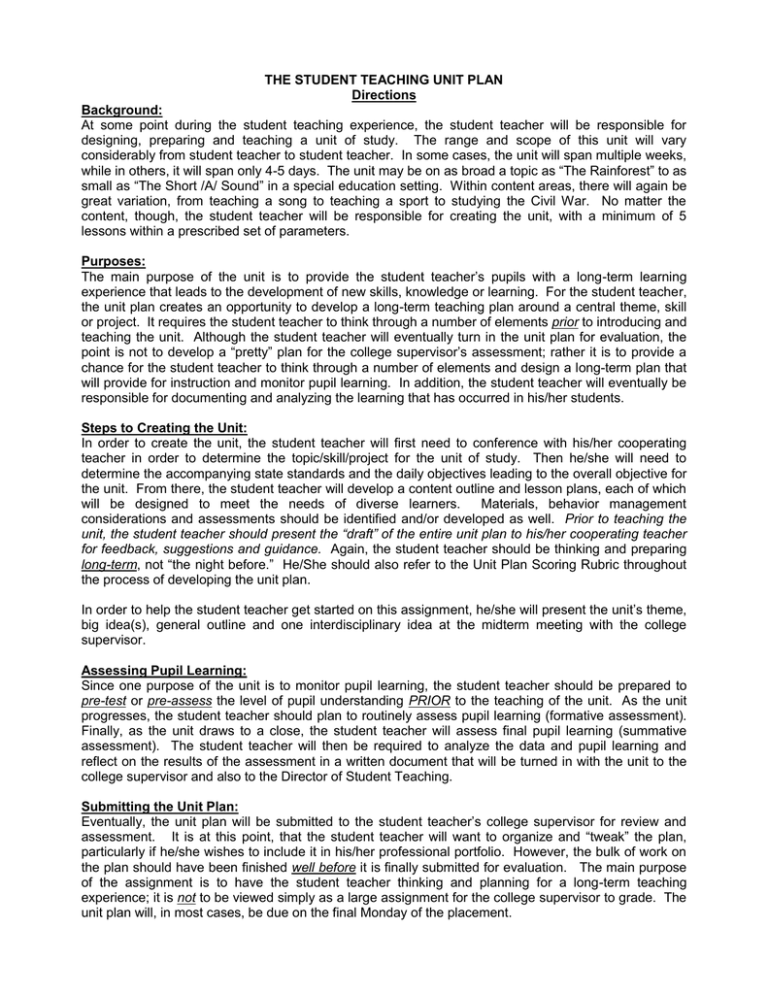
THE STUDENT TEACHING UNIT PLAN Directions Background: At some point during the student teaching experience, the student teacher will be responsible for designing, preparing and teaching a unit of study. The range and scope of this unit will vary considerably from student teacher to student teacher. In some cases, the unit will span multiple weeks, while in others, it will span only 4-5 days. The unit may be on as broad a topic as “The Rainforest” to as small as “The Short /A/ Sound” in a special education setting. Within content areas, there will again be great variation, from teaching a song to teaching a sport to studying the Civil War. No matter the content, though, the student teacher will be responsible for creating the unit, with a minimum of 5 lessons within a prescribed set of parameters. Purposes: The main purpose of the unit is to provide the student teacher’s pupils with a long-term learning experience that leads to the development of new skills, knowledge or learning. For the student teacher, the unit plan creates an opportunity to develop a long-term teaching plan around a central theme, skill or project. It requires the student teacher to think through a number of elements prior to introducing and teaching the unit. Although the student teacher will eventually turn in the unit plan for evaluation, the point is not to develop a “pretty” plan for the college supervisor’s assessment; rather it is to provide a chance for the student teacher to think through a number of elements and design a long-term plan that will provide for instruction and monitor pupil learning. In addition, the student teacher will eventually be responsible for documenting and analyzing the learning that has occurred in his/her students. Steps to Creating the Unit: In order to create the unit, the student teacher will first need to conference with his/her cooperating teacher in order to determine the topic/skill/project for the unit of study. Then he/she will need to determine the accompanying state standards and the daily objectives leading to the overall objective for the unit. From there, the student teacher will develop a content outline and lesson plans, each of which will be designed to meet the needs of diverse learners. Materials, behavior management considerations and assessments should be identified and/or developed as well. Prior to teaching the unit, the student teacher should present the “draft” of the entire unit plan to his/her cooperating teacher for feedback, suggestions and guidance. Again, the student teacher should be thinking and preparing long-term, not “the night before.” He/She should also refer to the Unit Plan Scoring Rubric throughout the process of developing the unit plan. In order to help the student teacher get started on this assignment, he/she will present the unit’s theme, big idea(s), general outline and one interdisciplinary idea at the midterm meeting with the college supervisor. Assessing Pupil Learning: Since one purpose of the unit is to monitor pupil learning, the student teacher should be prepared to pre-test or pre-assess the level of pupil understanding PRIOR to the teaching of the unit. As the unit progresses, the student teacher should plan to routinely assess pupil learning (formative assessment). Finally, as the unit draws to a close, the student teacher will assess final pupil learning (summative assessment). The student teacher will then be required to analyze the data and pupil learning and reflect on the results of the assessment in a written document that will be turned in with the unit to the college supervisor and also to the Director of Student Teaching. Submitting the Unit Plan: Eventually, the unit plan will be submitted to the student teacher’s college supervisor for review and assessment. It is at this point, that the student teacher will want to organize and “tweak” the plan, particularly if he/she wishes to include it in his/her professional portfolio. However, the bulk of work on the plan should have been finished well before it is finally submitted for evaluation. The main purpose of the assignment is to have the student teacher thinking and planning for a long-term teaching experience; it is not to be viewed simply as a large assignment for the college supervisor to grade. The unit plan will, in most cases, be due on the final Monday of the placement. PLANNING CHECKLIST (This is meant to be a guide and is not necessarily an all-inclusive listing.) PLANNING THE UNIT: Read through the scoring rubric for the unit plan Identify unit’s theme/skill/project in consultation with the cooperating teacher Identify Common Core State Standards, state or district standards Create unit’s overall objective(s) Develop daily lesson objectives Design an outline of the unit Present the theme, big ideas, general outline and an interdisciplinary idea at the midterm meeting with the college supervisor Determine pre-assessment tool as well as post-assessment Determine how to gather, store and analyze pupil data Develop individual lesson plans Develop materials and resource list Determine how to make the unit interdisciplinary and ready to meet all student needs Determine how and when students will be assessed o pre-assessment (related directly to unit’s objectives) o post-assessment (related directly to unit’s objectives) o formative assessments o summative assessment(s) Present preliminary draft of unit plan to cooperating teacher(s) in advance of unit’s start Finalize unit plan, including materials and plans for managing classroom behavior AFTER COMPLETING THE UNIT: Refer to the unit plan scoring rubric again Gather and organize all materials Gather pre-assessment data and compare to post-assessment data Analyze assessment data, focusing particularly on pupil learning “Tweak” the unit; correct errors; finalize contents Refer to the handout (“Student Teaching Unit Plan Reflection”) and corresponding rubric that explain the necessary components of the reflective portion of the unit plan. (This is critical!) Write a 1-3 page reflective paper that o records the pre- and post-assessment data o analyzes pupil learning, and o outlines what the student teacher would do, including what would be repeated or changed, should he/she reteach the unit at some future point. Submit the entire unit to the college supervisor by the published due date Submit just the Unit Reflection to the Director of Student Teaching Make a duplicate copy of the unit plan if desired Upload or include the unit plan in the professional portfolio Revised April 11, 2014 Student Teaching Unit Plan (Revised August 11, 2009) Overview Unit Objective Content Outline Theme Interdisciplinary Lesson Plans Meeting Diverse Needs Materials Excellent Proficient Developing Proficiency Unsatisfactory Included unit title, theme, grade level & content area; Explained thoroughly how the unit is aligned with the district’s curriculum; Provided a clear rationale for unit; Identified the “big ideas;” Identified all related state content standards & GLCEs; Wrote clear, specific, appropriate objectives for learners; Wrote objectives that can be clearly & easily assessed; Developed a clear sequence of daily objectives fully related to unit objective; Outlined the major concepts; Identified a clear, grade-appropriate theme that is fully related to the course content; Aligned all parts of unit to theme; Integrated literacy and 2 additional content areas into lessons; Included unit title, theme, grade level & content area; Explained in general how the unit is aligned with the district’s curriculum; Provided a rationale for the unit; Identified the “big ideas;” Identified related state content standards & GLCEs; Wrote appropriate objectives for learners; Wrote objectives that can be generally assessed; Developed a sequence of daily objectives related to unit objective; Outlined the major concepts to be taught; Identified a grade-appropriate theme that is generally related to the course content; Aligned most parts of unit to theme; Integrated literacy and 1 additional content area into lessons; Included unit title, theme, grade level & content area; Explained somewhat how the unit is aligned with the district’s curriculum; Provided a cursory rationale for the unit; Identified some of the “big ideas;” Identified most related state content standards & GLCE, but may have missed some; Wrote objectives for learners that may be somewhat unclear; Wrote objectives not easily assessed; Developed a skill sequence that is somewhat unclear, unsequenced and/or unrelated to the unit objective; Outlined some major concepts; Identified a theme that may not be fully related to the course content; Aligned some parts of unit to the theme; Integrated literacy or 1 additional content area into lessons; Failed to include unit title, theme, grade level and/or content area; Failed to explain how the unit is aligned with district’s curriculum; Failed to provide rationale for unit; Failed to identify the “big ideas;” Failed to identify related state content standards & GLCEs; Failed to write clear, specific, appropriate objectives for learners; Failed to write objectives that can be clearly & easily assessed; Failed to develop a clear sequence of daily objectives fully related to unit objective; Failed to outline major concepts; Failed to identify a clear, gradeappropriate theme related to the course content; Failed to align unit to the theme; Failed to integrate literacy and content areas into lessons; Developed lessons fully related to unit & daily objectives; Created lessons that are consistently accurate, engaging, creative & effective; Used appropriate formats for content area; Accounted for the needs of all diverse learners in plans & assessments; Addressed the multiple intelligences in multiple ways throughout the unit; Included multiple levels of Bloom’s Taxonomy throughout the unit & in assessments; Identified all materials needed for the unit & lessons; Selected materials that are appropriate, creative & varied; Cited all bibliographic information correctly; Developed lessons related to the unit & daily objectives; Created lessons that are generally accurate, interesting & engaging; Used appropriate formats for content area; Developed lessons related in part to the unit & daily objectives; Created lessons with limited accuracy, variety and/or creativity; Used formats that were incorrect or inappropriate for content area; Failed to develop lessons related to the unit & daily objectives; Failed to create lessons that are accurate, engaging or effective; Failed to use appropriate formats for content area; Accounted for most needs of diverse learners in lesson plans & assessments; Addressed the multiple intelligences in a number of lessons; Included multiple levels of Bloom’s Taxonomy in a number of lessons & assessments; Identified most materials needed for the unit & lessons; Selected materials that are appropriate & somewhat varied; Cited most bibliographic information correctly; Accounted for the needs of diverse learners in lesson plans & assessments in a limited manner; Addressed the multiple intelligences in some lessons; Tended to address same levels of Bloom’s Taxonomy in lessons & assessments; Identified materials needed for the unit & lessons; Selected materials that may or may not be appropriate and/or varied; Cited bibliographic information incorrectly; Failed to account for the needs of diverse learners in lesson plans & assessments; Failed to address the multiple intelligences in all lessons; Failed to include multiple levels of Bloom’s Taxonomy in lessons & assessments; Failed to identify materials needed for the unit & lessons; Failed to select materials that are appropriate, creative and/or varied; Failed to cite bibliographic information correctly; Behavior Management Assessments Developed a proactive plan to manage of behavior; Developed a clear, specific & ageappropriate plan; Designed method to inform students about behavior plan; Identified clear expectations & consequences; Developed a plan to manage behavior; Developed a clear & age-appropriate plan; Designed method to inform students about behavior plan; Identified expectations & consequences; Designed and explained methods to assess each lesson’s objective; Designed formative (on-going) and summative (end-unit) assessments clearly aligned with the unit’s objectives; Utilized alternative, authentic assessment methods; Identified alternative assessment methods for students with diverse learning needs; Designed methods to assess lessons’ objectives; Designed a formative and a summative (end-unit) assessment aligned with the unit’s objectives; Utilized some alternative, or authentic assessment methods; Identified at least 1 alternative assessment method for students with diverse learning needs; Developed a partial plan to manage behavior; Developed a plan that has some clarity, but may not be completely ageappropriate; Informed students in a haphazard manner about behavior plan; Identified some expectations & consequences; Designed assessments loosely aligned with the lessons’ objectives; Designed formative and/or summative (end-unit) assessments somewhat aligned with the unit’s objectives; Utilized repetitive assessment tools; Required all students to complete the same assessments without modification or recognition of diverse learning needs; Failed to develop a plan to manage behavior; Failed to develop a clear, specific and/or age-appropriate plan; Failed to design a way to inform students about the plan; Failed to identify clear expectations & consequences; Failed to design methods to assess each lesson’s objective; Failed to design formative and/or summative (end-unit) assessments aligned to the unit’s objectives; Failed to design alternative, authentic assessment methods; Did not design alternative assessment methods for students with diverse learning needs; EFFECT OF CANDIDATE’S TEACHING ON STUDENT LEARNING PreAssessment PostAssessment Reflection on Assessment Due Date Total Grade: Designed and administered an original pre-assessment that measured students’ knowledge prior to teaching the unit; Designed and administered an original post-assessment that measured students’ learning after teaching the unit; Wrote a reflection that analyzed the effects of teaching on students’ learning; identified several adjustments to instruction made as a result; demonstrated a positive effect on student learning; Administered a pre-assessment that measured students’ knowledge prior to teaching the unit; Administered a pre-assessment that somewhat measured students’ knowledge prior to teaching the unit; Administered a post-assessment that measured students’ learning after teaching the unit; Administered a post-assessment that somewhat measured students’ knowledge after teaching the unit; Wrote a reflection that analyzed the effects of teaching on students’ learning; identified a few adjustments to instruction made as a result; demonstrated a positive effect on student learning; Wrote a reflection that partially analyzed the effects of teaching on students’ learning; identified an adjustment to instruction made as a result; Turned in unit early or by the assigned due date; Turned in unit within a day of the assigned due date; A = Most ratings (11 of 14 categories) rated in the Excellent range B = Many ratings (10 of 14 categories) rated in the Excellent range; others in Proficient range; Turned in the unit a few days late; made the college supervisor ask repeatedly for the unit to be submitted; C = All categories rated in the Proficient or Developing Proficiency ranges; Administered a haphazard or incomplete measure of students’ prior knowledge OR did not administer a pre-assessment; Administered a haphazard or incomplete measure of students’ learning OR did not administer a post-assessment; Wrote a minimal reflection that only touched on the students’ learning OR did not reflect on student learning; Turned in the unit late or failed to turn in the unit; D or F = Most ratings in the Developing Proficiency or Unsatisfactory ranges;
